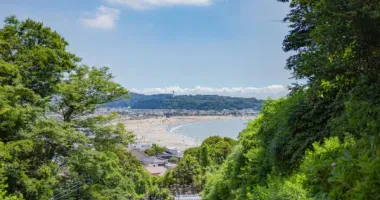Hasedera Temple Kamakura
Hasedera Temple in Kamakura is famous for having one of the largest wooden statues in Japan, that of Kannon, the Goddess of Mercy.
- History of Hasedera Temple
- Hasedera Temple Layout & Buildings
- The Kannon Museum
- Hasedera Temple Hours & Admission
- Hasedera Temple Access
- Kamakura Temples & Shrines
- Japan Temples & Shrines
Hasedera Temple Kamakura 長谷観音
Hasedera Temple (長谷観音), in Kamakura, aka Hasedera Kannon, is famous for having one of the largest wooden statues in Japan, that of Kannon, the Goddess of Mercy.
Today, Hasedera belongs to the Jodo sect of Japanese Buddhism, after its initial foundation as a Tendai sect temple.
 Hasedera Temple, Kamakura
Hasedera Temple, Kamakura Hasedera Temple, Kamakura
Hasedera Temple, Kamakura
Hasedera Temple History
According to legend, Hasedera Temple was founded in 736. This occurred, so the story goes, after the monk Tokudo Shonin found a huge camphor tree in the forests of Nara in 721.
He cut the tree in half and carved two statues of the Eleven-headed Kannon. The smaller, lower half was placed in what is now Hasedera Temple in Nara Prefecture.
The larger, upper half was thrown into the sea and washed up on the Miura Peninsula in 736 and a temple was soon founded to house the sacred image.
The statue stands 9.3m tall and is covered in gold leaf, which was added in the 14th century during the Kamakura Period of Japanese history.
 Jizo Statues, Hasedera Temple, Kamakura
Jizo Statues, Hasedera Temple, Kamakura Jizo statues among the higanbana, Hasedera Temple, Kamakura
Jizo statues among the higanbana, Hasedera Temple, Kamakura
Hasedera Temple Layout & Buildings
Hasedera Temple is located about halfway up Mount Kamakura. The temple, therefore, has excellent views south over the ocean and the picturesque Yuigahama Beach.
There are seven main buildings in the temple complex and surrounding garden grounds.
The Main Hall (Hondo) is flanked by two smaller halls one holding a statue of the Amidha Buddha carved in 1189 for Minamoto Yoritomo's 42nd birthday to ward off evil influences associated with that age and the other having an image of Daikoku.
Hasedera Temple is built on two levels and includes the Benten kutsu, a long, winding tunnel, with numerous statues of Benzaiten, the only female member of the Shichifukujin, the Seven Lucky Gods.
Scattered throughout the temple grounds are thousands of small statues of Jizo, dedicated to children lost in miscarriage, stillbirth, or abortion.
The months of June and July see the grounds full of blooming hydrangeas.
Hasedera's Temple Bell was cast in 1624 and is one of the oldest such bells in the Kanto region.
Hasedera is part of two pilgrimage routes: the Bando Sanjusankasho pilgrimage route dedicated to Benzaiten and
the Kanto Pilgrimage.
The Kannon Museum
The Hasedera Homotsuka displays the celebrated Eleven-headed Kannon along with a number of other historic pieces. These include an Edo Period standing Eleven-headed Kannon statue, a 13th century temple bell, hanging plaques from the Kamakura and Muromachi periods, picture scrolls, calligraphy and historic documents.
Hasedera Temple Hours and Admission
Hasedera Temple is open from 8am to 5pm March to September; 8am to 4.30pm October to February
Admission is 300 yen to the temple grounds and an additional 300 yen to the museum.
Access - how to get to Hasedera Temple in Kamakura
Hasedera Temple is a short walk from Hase Station on the Enoden Line to Enoshima.
Kamakura is located in Kanagawa Prefecture, south of Tokyo and under an hour by a JR Yokosuka train from Tokyo Station.
Hasedera Temple (hasedera.jp in Japanese & English)
3-11-2 Hase
Kamakura
Kanagawa Prefecture
248-0016
Tel: 0467 22 6300
Hasedera Temple is just five minutes on foot to Kotokuin Temple and the Kamakura Daibutsu. Hasedera is also close to Kosokuji Temple.














